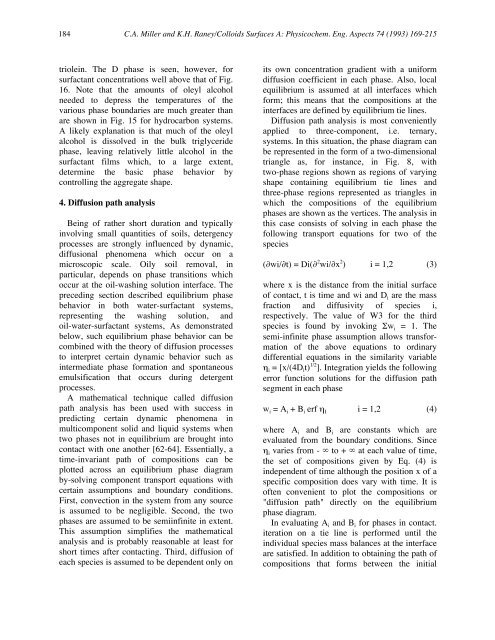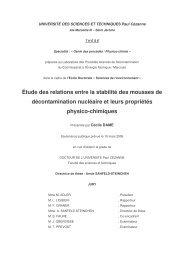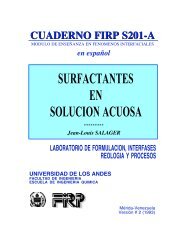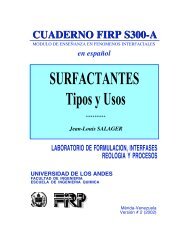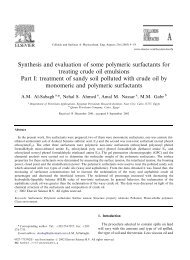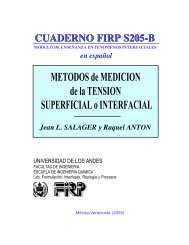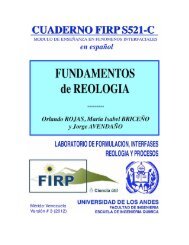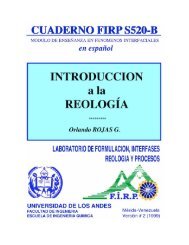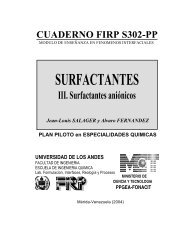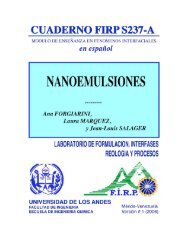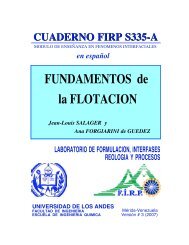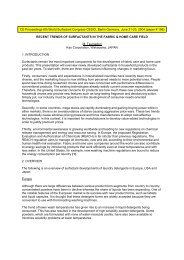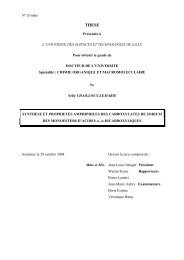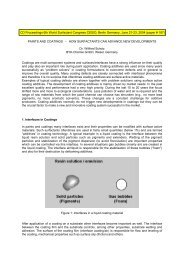Solubilization-emulsification mechanisms of detergency
Solubilization-emulsification mechanisms of detergency
Solubilization-emulsification mechanisms of detergency
Create successful ePaper yourself
Turn your PDF publications into a flip-book with our unique Google optimized e-Paper software.
184 C.A. Miller and K.H. Raney/Colloids Surfaces A: Physicochem. Eng. Aspects 74 (1993) 169-215<br />
triolein. The D phase is seen, however, for<br />
surfactant concentrations well above that <strong>of</strong> Fig.<br />
16. Note that the amounts <strong>of</strong> oleyl alcohol<br />
needed to depress the temperatures <strong>of</strong> the<br />
various phase boundaries are much greater than<br />
are shown in Fig. 15 for hydrocarbon systems.<br />
A likely explanation is that much <strong>of</strong> the oleyl<br />
alcohol is dissolved in the bulk triglyceride<br />
phase, leaving relatively little alcohol in the<br />
surfactant films which, to a large extent,<br />
determine the basic phase behavior by<br />
controlling the aggregate shape.<br />
4. Diffusion path analysis<br />
Being <strong>of</strong> rather short duration and typically<br />
involving small quantities <strong>of</strong> soils, <strong>detergency</strong><br />
processes are strongly influenced by dynamic,<br />
diffusional phenomena which occur on a<br />
microscopic scale. Oily soil removal, in<br />
particular, depends on phase transitions which<br />
occur at the oil-washing solution interface. The<br />
preceding section described equilibrium phase<br />
behavior in both water-surfactant systems,<br />
representing the washing solution, and<br />
oil-water-surfactant systems, As demonstrated<br />
below, such equilibrium phase behavior can be<br />
combined with the theory <strong>of</strong> diffusion processes<br />
to interpret certain dynamic behavior such as<br />
intermediate phase formation and spontaneous<br />
<strong>emulsification</strong> that occurs during detergent<br />
processes.<br />
A mathematical technique called diffusion<br />
path analysis has been used with success in<br />
predicting certain dynamic phenomena in<br />
multicomponent solid and liquid systems when<br />
two phases not in equilibrium are brought into<br />
contact with one another [62-64]. Essentially, a<br />
time-invariant path <strong>of</strong> compositions can be<br />
plotted across an equilibrium phase diagram<br />
by-solving component transport equations with<br />
certain assumptions and boundary conditions.<br />
First, convection in the system from any source<br />
is assumed to be negligible. Second, the two<br />
phases are assumed to be semiinfinite in extent.<br />
This assumption simplifies the mathematical<br />
analysis and is probably reasonable at least for<br />
short times after contacting. Third, diffusion <strong>of</strong><br />
each species is assumed to be dependent only on<br />
its own concentration gradient with a uniform<br />
diffusion coefficient in each phase. Also, local<br />
equilibrium is assumed at all interfaces which<br />
form; this means that the compositions at the<br />
interfaces are defined by equilibrium tie lines.<br />
Diffusion path analysis is most conveniently<br />
applied to three-component, i.e. ternary,<br />
systems. In this situation, the phase diagram can<br />
be represented in the form <strong>of</strong> a two-dimensional<br />
triangle as, for instance, in Fig. 8, with<br />
two-phase regions shown as regions <strong>of</strong> varying<br />
shape containing equilibrium tie lines and<br />
three-phase regions represented as triangles in<br />
which the compositions <strong>of</strong> the equilibrium<br />
phases are shown as the vertices. The analysis in<br />
this case consists <strong>of</strong> solving in each phase the<br />
following transport equations for two <strong>of</strong> the<br />
species<br />
(∂wi/∂t) = Di(∂ 2 wi/∂x 2 ) i = 1,2 (3)<br />
where x is the distance from the initial surface<br />
<strong>of</strong> contact, t is time and wi and D i are the mass<br />
fraction and diffusivity <strong>of</strong> species i,<br />
respectively. The value <strong>of</strong> W3 for the third<br />
species is found by invoking Σw i = 1. The<br />
semi-infinite phase assumption allows transformation<br />
<strong>of</strong> the above equations to ordinary<br />
differential equations in the similarity variable<br />
η i = [x/(4D it) 1/2 ]. Integration yields the following<br />
error function solutions for the diffusion path<br />
segment in each phase<br />
w i = A i + B i erf η I i = 1,2 (4)<br />
where A i and B i are constants which are<br />
evaluated from the boundary conditions. Since<br />
η i varies from - ∞ to + ∞ at each value <strong>of</strong> time,<br />
the set <strong>of</strong> compositions given by Eq. (4) is<br />
independent <strong>of</strong> time although the position x <strong>of</strong> a<br />
specific composition does vary with time. It is<br />
<strong>of</strong>ten convenient to plot the compositions or<br />
"diffusion path" directly on the equilibrium<br />
phase diagram.<br />
In evaluating A i and B i for phases in contact.<br />
iteration on a tie line is performed until the<br />
individual species mass balances at the interface<br />
are satisfied. In addition to obtaining the path <strong>of</strong><br />
compositions that forms between the initial


